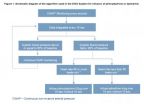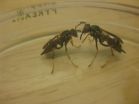(Press-News.org) Austin – February 10, 2014 – With Valentine's Day around the corner, you may be thinking of pairing up two friends for a date. If you follow your instinct to play Cupid, it'll pay off in happiness – not necessarily for the new couple, but definitely for you.
According to new research, matchmaking, a time-honored tradition, brings intrinsic happiness to the matchmaker. To maximize the psychological benefits of matchmaking, you should take care to introduce two people who not only seem compatible but who would be unlikely to meet otherwise, researchers say.
"At some point, most people have made matches between others – like grabbing two strangers by the arm at a party and introducing them to each other – or can think of a friend notorious for their efforts to make introductions," says Lalin Anik, a postdoctoral fellow at Duke University's Fuqua School of Business. She notes that the rising popularity of social networking websites such as Facebook and LinkedIn has made matchmaking effortless and central to social life.
Anik, with her colleague Michael Norton of the Harvard Business School, conducted an in-depth investigation of modern-day matchmaking, examining what motivates us to match others – even when it often goes wrong – and how we can reap the emotional benefits of socially linking others. In four studies, to be presented this week at the Society for Personality and Social Psychology (SPSP) annual conference in Austin, they used surveys, computer games, and in-lab social interactions to show when and why making matches between others boosts happiness.
In one study, the researchers asked groups of participants to engage in a brief "get acquainted" task in the laboratory. They then asked participants to pair others in the group: One group of participants had to match pairs that they thought would get along; another group tried to match pairs that they thought would not get along; and a third group matched people on the basis of a random characteristic – their social security numbers. Participants who selected pairs of people who they thought would bond became happier as a result of their matchmaking. Those in the other two groups felt the same as they did before the task.
In another study, the researchers created a simple computer game in which participants saw a target face and selected one of three other faces with whom they thought the target would best or worst get along. Once again, the matchmakers had the best experience and were willing to play the game much longer than participants asked to pair people on the basis of mutual dislike.
Some participants received monetary rewards for each match made, while others did not. Interestingly, the researchers found that paying people diminished their interest in the game. "Participants who made matches between others for free persisted on the matchmaking task much longer than participants who were offered money," Anik says. These results challenge the rising trend of online social networks providing financial incentives for people to make introductions.
Another surprising result of the new studies, published today in the journal Social Psychological and Personality Science, was that matchmaking brings the most happiness to those who pair together two people who are less likely to meet. Making matches between people who are already likely to be members of the same social network, for example, two White women, is not as rewarding as making matches between people less likely to be in the same network, for example, a White woman and an Asian man, Anik says.
"There are many reasons why people make matches," Anik says. "Matchmakers may be proud that they have the social acumen to recognize a social link that others hadn't." In addition, people may enjoy matchmaking because they view it as an act of kindness. And, of course, "people enjoy being the key person who made that critical match between newlyweds or between business partners who started a successful venture."
Future work will further explore the costs to people's emotions and reputations when matchmaking goes wrong: Think of setting up two acquaintances on the worst date of their lives.
"The study of matchmaking is especially timely now as social structures, as well as definitions of social ties and friendships, are changing," Anik says. "Our exploration of matchmaking can help people to navigate their increasingly complex social webs."
In the meantime, this Valentine's Day, Anik and Norton encourage everyone to make matches – romantic and otherwise. They suggest caution as well, however, referencing a past episode of The Office: "In a Valentine's Day episode, Michael Scott introduces Eric – who is interested in tool and die repair – to Meredith – who had a hysterectomy – emphasizing the 'repair' aspect as a common ground. Not surprisingly, the introduction is brutally awkward," Anik says. "Matches should be made with the goal of creating meaningful connections."
INFORMATION:
Anik and Norton are presenting this research in Symposium S-A1, "Let's Get Connected: New and Untapped Routes to Social Connection," (Session A) on Friday, Feb. 14, 2014, at the SPSP annual meeting. More than 3,500 scientists are in attendance at the conference in Austin from Feb. 13-15. Follow the meeting on Twitter: #SPSP2014, @SPSPnews.
Read our new blog spspblog.org, #SPSPblog for coverage of the conference and news and perspectives on personality and social psychology.
SPSP (promotes scientific research that explores how people think, behave, feel, and interact. With more than 6,000 members, the Society is the largest organization of social and personality psychologists in the world.
The journal Social Psychological and Personality Science is a collaboration from the Association for Research in Personality, the European Association of Social Psychology, the Society of Experimental Social Psychology, and SPSP, and is co-sponsored by the Asian Association of Social Psychology and Society of Australasian Social Psychologists. The paper, "Matchmaking Promotes Happiness," is being published online on February, 10, 2014.
Matchmaking this Valentine's Day: How it can bring you the most happiness
2014-02-10
ELSE PRESS RELEASES FROM THIS DATE:
Genetic discovery to keep crops disease-free
2014-02-10
Curtin University researchers have found a way to breed disease-resistant wheat with no downside, potentially bringing multi-million dollar savings to Australia's agricultural industry.
According to John Curtin Distinguished Professor Richard Oliver, Director of the Australian Centre for Necrotrophic Fungal Pathogens (ACNFP) at Curtin, farmers can lose more than 0.35 tonnes per hectare in wheat yields to Yellow Spot, even after applying fungicide.
For an average-sized farm of 4000 hectares, this could mean an almost $500,000 loss to disease per year – or about $212 ...
Slowing down the immune system when in overdrive
2014-02-10
Many people suffer from chronic inflammation because their immune systems overreact to 'self' tissue. Sydney scientists believe that a small molecule known as Interleukin 21 is a promising therapeutic target in such cases.
Interleukin 21 (IL-21) is one of a group of chemical messengers known as 'cytokines', which affect the behaviour of immune cells. IL-21 is already well known to play an important role in autoimmune diseases such as Sjögren's syndrome and type 1 diabetes.
The current study shows how much IL-21 contributes to inflammation. It also shows how important ...
When you always gotta go…
2014-02-10
Problems related to urination, including incontinence and having to get up to urinate at night-time, have become more acceptable topics of discussion over recent years. New treatment options have also led doctors to address these symptoms more actively. Despite this, no study has effectively compared the bother of each of these bladder symptoms for men and women of all ages.
The FINNO Study is an ongoing questionnaire survey conducted right across Finland. A random sample of 6,000 adults identified from the Finnish Population Register, were contacted with a questionnaire ...
New trial results affirm better blood pressure management during C-section
2014-02-10
10 February 2014, Singapore: New trial results1 have shown that the world's first Double
Intravenous Vasopressor Automated (DIVA) System affords superior control of maternal blood pressure in women undergoing caesarean section under spinal anaesthesia, when compared with manually-administered medication to manage reduced blood pressure (vasopressor).
Developed by doctors at KK Women's and Children's Hospital (KKH), the novel DIVA System detects and responds rapidly to low blood pressure and/or slow heart rate in real time by auto-administering a precise amount of the ...
Normal enzyme aids a mutant 1 to fuel blood cancer's growth
2014-02-10
BOSTON (Feb. 10, 2014)—Reinforcing the need to look beyond genomic alterations to understand the complexity of cancer, researchers from Dana-Farber/Boston Children's Cancer and Blood Disorders Center report that a normal enzyme called SYK pairs with FLT3, the most commonly mutated enzyme found in acute myelogenous leukemia (AML), to promote progression of the disease. This molecular partnership also promotes AML cells' resistance to treatment with FLT3-blocking drugs, potentially explaining the relatively poor showing of FLT3 inhibitors in multiple clinical studies. In ...
Flat-pack lens boosts solar power
2014-02-10
Micro-machining could be used to create almost flat, Fresnel lenses, that boost the electrical efficiency of solar panels, according to researchers in China.
Fresnel lenses were invented by French engineer and scientist Augustin-Jean Fresnel, in the early nineteenth century, they are essential two-dimensional equivalents of conventional optical lens, but they have ridges in concentric rings that focus the light to a point behind the lens without the three-dimensional bulk of a conventional lens. Image quality is reduced when using a Fresnel lens to focus because the concentric ...
Study reveals unexpected cell hijack method in pancreatic cancer
2014-02-10
Pancreatic stellate cells, which normally aid tissue repair, unwittingly help pancreatic cancer grow and spread in a method of 'cell hijack' only seen before in brain and breast cancer, according to new research from Queen Mary University of London.
The research, published in the latest issue of EMBO Molecular Medicine and carried out by Queen Mary's Barts Cancer Institute, also revealed the process can be blocked, thereby preventing the growth and spread of the tumour.
The study, funded by the UK charity Pancreatic Cancer Research Fund, set out to investigate the messaging ...
EORTC characterizes responders & survivors on pazopanib for advanced soft tissue sarcoma
2014-02-10
An EORTC analysis appearing in Annals of Oncology confirmed the importance of known prognostic factors such as performance status and tumor grading for having a long-term outcome in patients treated with pazopanib for metastatic soft tissue sarcoma. Additionally, hemoglobin at baseline was found to be a new prognostic factor.
Soft tissue sarcomas are a heterogeneous and relatively rare tumor with an estimated incidence of four per 100,000 people per year in Europe. The prognosis for patients with this disease is favorable if they are diagnosed at an early stage and if ...
Massive neutrinos solve a cosmological conundrum
2014-02-10
Scientists have solved a major problem with the current standard model of cosmology identified by combining results from the Planck spacecraft and measurements of gravitational lensing in order to deduce the mass of ghostly sub-atomic particles called neutrinos.
The team, from the universities of Manchester and Nottingham, used observations of the Big Bang and the curvature of space-time to accurately measure the mass of these elementary particles for the first time.
The recent Planck spacecraft observations of the Cosmic Microwave Background (CMB) – the fading glow ...
Wasps use ancient aggression genes to create social groups
2014-02-10
Aggression-causing genes appeared early in animal evolution and have maintained their roles for millions of years and across many species, even though animal aggression today varies widely from territorial fighting to setting up social hierarchies, according to researchers from Iowa State University, Penn State and Grand Valley State University.
If these "mean genes" keep their roles in different animals and in different contexts, then perhaps model organisms -- such as bees and mice -- can provide insights into the biological basis of aggression in all animals, including ...


